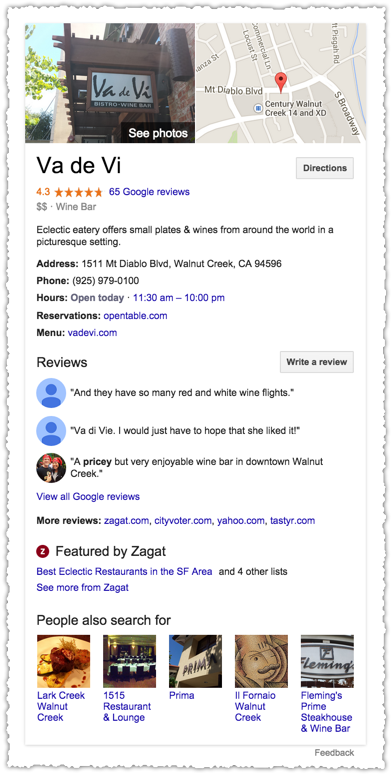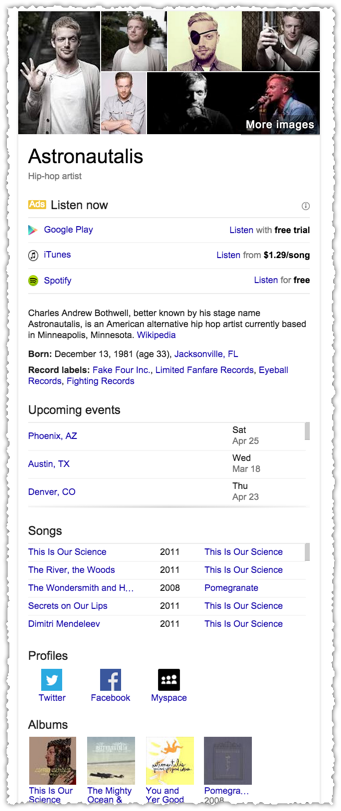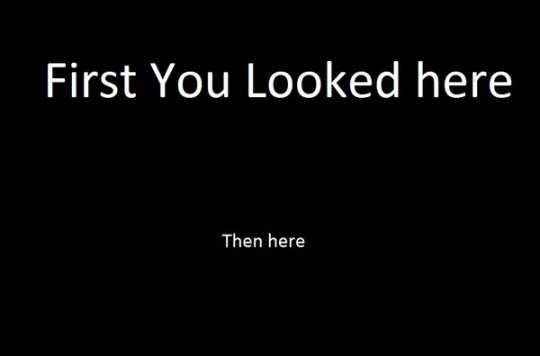Successful search engine optimization strategies must aggregate intent. This is something I touched on in my What Is SEO post and also demonstrated in my Rich Snippets Algorithm piece. But I want to talk about it in depth because it’s that important.
Aggregating Intent
Many of Google’s Knowledge Cards aggregate intent. Here’s the Knowledge Card displayed when I search for ‘va de vi’.

Google knows that Va de Vi is a restaurant. But they don’t quite know what my intent is behind such a broad query. Before Knowledge Cards Google would rely on providing a mixture of results to satisfy different intents. This was effective but inefficient and incomplete. Knowledge Cards makes aggregating intent a breeze.
What type of restaurant is it? Is it expensive? Where is it? How do I get there? What’s their phone number? Can I make a reservation? What’s on the menu? Is the food good? Is it open now? What alternatives are nearby?
Just look at that! In one snapshot this Knowledge Card satisfies a multitude of intents and does so quickly.
It’s not just restaurants either. Here’s a Knowledge Card result for ‘astronautalis’.

Once again you can see a variety of intents addressed by this Knowledge Card. Who is Astronautalis? Can I listen to some of his music? Where is he playing next? What are some of his popular songs? How can I connect with him? What albums has he released?
Google uses Knowledge Cards to quickly aggregate multiple intents and essentially cover all their bases when it comes to entity based results. If it’s good enough for Google shouldn’t it be good enough for you?
Active and Passive Intent

So how does this translate into the search strategies you and I can implement? The easiest way to think about this is to understand that each query comes with active and passive intent.
Active intent is the intent that is explicitly described by the query syntax. A search for ‘bike trails in walnut creek’ is explicitly looking for a list of bike trails in walnut creek. (Thank you captain obvious.)
You must satisfy active intent immediately.
If a user doesn’t immediately see that their active intent has been satisfied they’re going to head back to search results. Trust me, you don’t want that. Google doesn’t like pogosticking. This means that at a glance users must see the answer to their active intent.
One of the mistakes I see many making is addressing active and passive intent equally. Or simply not paying attention to query syntax and decoding intent properly. More than ever, your job as an SEO is to extract intents from query syntax.
Passive intent is the intent that is implicitly described by the query syntax. A search for ‘bike trails in walnut creek’ is implicitly looking for trail maps, trail photos, trail reviews and attributes about those trails such as difficulty and length to name a few.
You create value by satisfying passive intent.
When you satisfy passive intent you’ll see page views per session and time on site increase. You’re ensuring that your site generates long clicks, which is incredibly important from a search engine perspective. It also happens to be the way you build your brand, convert users and ween yourself from being overly dependent on search engine traffic.
I think one of the best ways to think about passive intent is to ask yourself what the user would search for next … over and over again.
Intent Hierarchy

It’s essential to understand the hierarchy of intent so you can deliver the right experience. This is where content and design collide with “traditional” search. (I use the quotes here because I’ve never really subscribed to search being treated as a niche tactic.)
SEO is a user centric activity in this context. The content must satisfy active and passive intent appropriately. Usually this means that there is ample content to address active intent and units or snippets to satisfy passive intent.
The design must prominently feature active intent content while providing visual cues or a trail of sorts to show that passive intent can also be satisfied. These things are important to SEO.
We can look at Google’s Knowledge Cards to see how they prioritize intent. Sometimes it’s the order in which the content is presented. For instance, usually the ‘people also search for’ is at the bottom of the card. These alternatives always represent passive intent.
For location based entities the map and directions are clearly given more priority by being at the top (and having a strong call to action). While the reviews section is often presented later on, it takes up a material amount of real estate (look into https://webuyhousesinatlanta.com/ site to get daily updates about the real estate trend), signaling higher (and potentially active) intent. Those with more passive intent (address, phone, hours etc.) are still available but are not given as high a weight visually.
For an artist (such as Astonautalis) you’ll see that listening options are presented first. Yes, it’s an ad based unit but it also makes sense that this would be an active intent around these queries.
It’s up to us to work with content and design teams to ensure the hierarchy of intent is optimized. Simply putting everything on the page at once or with equal weight will distract or overwhelm the user and chase them back to search results or a competitor.
Decoding Intent

While the days of having one page for every variant of query syntax are behind us, we’re still not at the point where one page can address every query syntax and the intents behind them.
If I search for ‘head like a hole lyrics’ the page I reach should satisfy my active intent and deliver the lyrics to this epic NIN song. To serve passive intent I’d want to see a crosslink unit to other songs from Pretty Hate Machine as well as other NIN albums. Maybe there’s another section with links to songs with similar themes.
But if I search for ‘pretty hate machine lyrics’ the page I reach should have a list of songs from that album with each song linking to a page with its lyrics. The crosslink unit on this page would be to other NIN albums and potentially other similar artists albums.
By understanding the query syntax (and in this case query classes) you can construct different page types that address the right hierarchy of intent.
Target the keyword, optimize the intent.
TL;DR
Aggregating intent and understanding how to decode, identify and present active and passive intent from query syntax is vital to success in search and beyond.
The Next Post: Non-Linking URLs Seen As Links
The Previous Post: Roundup Posts

4 trackbacks/pingbacks
Comments About Aggregating Intent
// 12 comments so far.
Joshua // March 13th 2015
Well said. I would add that the days of one page addressing every query syntax are coming faster then we think. Now with ajax and all these + signs that expand menus and content blocks, soon we will have pages that show certain blocks open depending on search phrase. There is a problem with google because it blocks most trafficked search terms, but it would work for long tail…
AJ Kohn // March 14th 2015
Thank you for your comment Joshua. I’m not sure we’ll get to one page that quickly. We’ll certainly close the gap with more flexible and fluid presentations that allow for more content to be presented without overwhelming or distracting.
But for this to really work we’d need to know the query syntax upon loading the page so it could dynamically present the right intent. Unfortunately we’re getting less visibility here and not more.
Phil Rozek // March 14th 2015
Bang-up post, AJ. The “passive intent” concept is a forehead-slapper – makes perfect sense, but I’d never heard the term (an AJ-ism?).
I’m surprised Google doesn’t scratch more passive-intent itches in the *local* version of the KG.
Yes, the intent in “local” is somewhat clearer: most people are searching for a specific business, usually by name. I would think that would make Google’s job (satisfying both active and passive intent) even easier, because it understands the user that much better. Sure, Google shows reviews, hours, contact info, etc. And yes, if someone’s looking up Louie the one-truck plumber without a website, there’s only so much Google can show about him as an “entity.” But even if you Google “House of Blues Dallas” Google doesn’t show things like upcoming shows, deals, etc.
It just seems that in the local KG Google pays waayyy less attention to passive intent – and almost sees all local queries as having “active” intent. (Which would be a shame.)
AJ Kohn // March 14th 2015
Thank you for the kind words and comment Phil. I’m not quite sure whether I picked up the term passive intent from somewhere else or if I just started referring to it organically. I just know I’ve been using the terminology within my business for the last three or four years.
I agree that Google could be doing more with passive intent around local knowledge cards. Shows, deals, meet-ups and more could be super useful. Frankly, I think Google’s running very fast here with this new concept. Aggregating intent in these Knowledge Cards is a rather new feature and truly does disrupt the traditional ten blue links.
And local has always been thorny for Google because the data isn’t as structured or uniform as they’d like it to be. So I think they’ll get there but it’s going to take some time.
Chris Menke // March 14th 2015
Thanks A.J. So now we’ve got the “Kohn’s heirarchy of intent” theory of SEO/design. It may not be long before it becomes the reason that all homepages and landing pages begin looking like a knowledge card–and then a useless spam tactic. At least we have the meantime.
In one respect, it feels like the old days of SEO–what terms to use and where to use them on the page. On the other hand, how we choose those words is different. Before, an “SEO” could, almost blindly, look to those old keywords tools that showed search terms and their frequencies. Now, without those tools, blending into the page content the passive goals of the visitor lets us optimize more for the visitor than for algorithm.
I think clients will have a hard time understanding how we’re going to be trying to explain all this to them.
AJ Kohn // March 14th 2015
Ha. “Kohn’s Hierarchy of Intent’. I like that Chris.
I hope people don’t take the Knowledge Card examples literally but instead use it as a guide. Sadly, you may wind up being right.
You’re also right that without having all the keyword information forced many to … actually think about those visitors instead of just keywords. So while I’d prefer to have the visibility myself I think overall it may have helped as a whole.
I’m lucky that most of my clients grok this new landscape but I still get (and pass on) plenty of inbound requests for help in ranking for 5 specific keywords or what link packages I can deliver along with a question about how long it takes to guarantee results.
The truth is that it takes more time and effort to win at search than it ever has before. Some people just don’t want to hear that.
Andrew Akesson // March 16th 2015
Hey AJ
A great post you’ve written there and a site that I think satisfies passive intent better than any other is bbc.co.uk (I’m not sure whether the rest of the world can get to the BBC through that URL though?) and a perfect model to replicate when building websites. If you click on a news item, you are then presented with the the bulk copy of the story and the sidebar presents you with most watched videos, most read articles, related articles etc etc, its like an endless supply of content and the time to long click must be huge with that website.
What you are implying in the following sentence is completely true…
“I think one of the best ways to think about passive intent is to ask yourself what the user would search for next … over and over again.”
The BBC are able to satisfy the passive intent of the user as they use several forms of media (the BBC has several radio channels, iPlayer and the typed word), so they always have the ability to keep the user on site until they have found the appropriate way to satisfy their intent. By using different forms of media you can almost guarantee that you can satisfy the user (especially for passive intent) but how can you continually and successfully complete this task if you simply don’t have the budget to provide content through different forms of media? Active intent is relatively easy to fulfil for a website, but in my mind, only the bigger budgeted websites can continually fulfil passive intent.
AJ Kohn // March 18th 2015
Andrew,
The BBC does a decent job and certainly excels at providing related content in a variety of media types. I’d probably dial back the number of options and ensure that the ones presented are always hyper relevant. Sometimes it feels like they’re throwing a little too much in front of users before they satisfy active intent.
I agree that it sometimes takes a lot to continually fulfill passive intent. In general, large sites that can develop appropriate templates and sidebar/crosslink units at scale are the ones who can do this. But even a B2B site can develop good resource pages that satisfy passive intent. It won’t be at scale but not everyone needs to do it at scale.
James // March 17th 2015
Great post AJ, I really like the concept of mapping a hierarchy of intent before any page design work etc…
AJ Kohn // March 18th 2015
Thanks James. It’s fantastic if you can map the hierarchy of intent before design. However (and unfortunately), I generally find that it happens after the fact.
bill bean // March 20th 2015
I’m going to push back a little on the design issue referenced by Chris Menkie, that of designing pages like Knowledge Cards.
Granted, any design approach or style can be overdone, so one-size-fits-all is not the best approach. However, if the majority of users are being “trained” by the appearance of Knowledge Cards and similar layouts, wouldn’t it make sense to give them something like what they’re most often seeing? (again, it really depends on the query space, website, etc…)
I’m thinking this is another aspect of design that is being greatly influenced or impacted by mobile.
Matt Gardner // March 12th 2018
Another great post AJ, straight to the point and meets my intent perfectly, I’ll putting some time aside each week to go back through some of your earlier posts to dig out some more gold.
Please keep posting stuff like this.
Sorry, comments for this entry are closed at this time.
You can follow any responses to this entry via its RSS comments feed.